

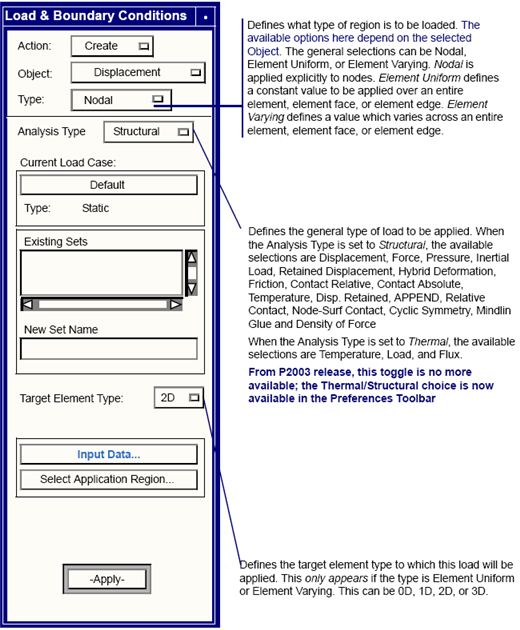
Analysis Type | Object | Type |
Structural | Nodal | |
• Force | Nodal | |
• Pressure | Element Uniform Element Variable | |
Element Uniform | ||
Nodal | ||
Nodal | ||
Nodal | ||
Nodal | ||
Element Uniform | ||
• Append | Nodal | |
Nodal Element Uniform | ||
Nodal Element Uniform | ||
Element Uniform |
Analysis Type | Object | Type |
Thermal | • Temperature (Thermal) | Nodal |
• Initial Temperature | Nodal | |
• Load | Nodal | |
• (S) Prescr. Temp. t=0. | Nodal | |
• (S) Volumic Convection | Nodal | |
• (S) Surfacic Flux | Element Uniform | |
• (S) Convection | Element Uniform | |
• (S) Volumic Flux | Element Uniform | |
• (S) Therùal Gluing | Element Uniform | |
• (S) Thermal Stick | Element Uniform |
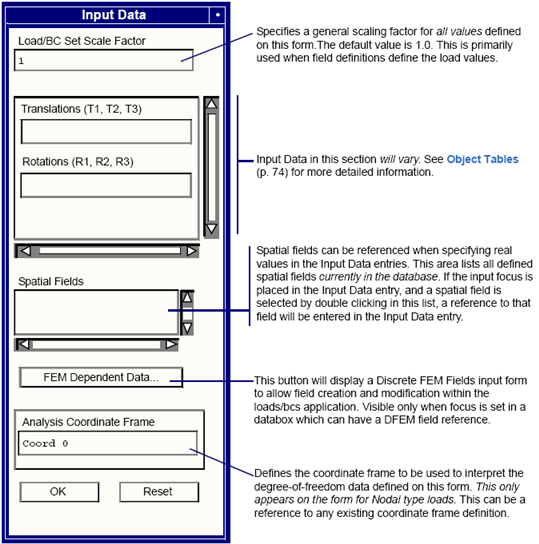
Object | Type | Type |
Displacement | Nodal | Structural |
Input Data | Description |
Translations (T1,T2,T3) | Defines the enforced translational displacement values. These are in model length units. |
Rotations (R1,R2,R3) | Defines the enforced rotational displacement values. These are in degrees. |
Important: | Use this boundary condition to define sliding surfaces by controlling translations in a coordinate frame with one axis normal to the surface. |
Object | Type | Type |
Force | Nodal | Structural |
Input Data | Description |
Force (F1,F2,F3) | Defines the applied forces in the translation degrees-of-freedom. |
Moment (M1,M2,M3) | Defines the applied moments in the rotational degrees-of-freedom. |
Object | Type | Type | Dimension |
Pressure | Element Uniform Element Variable | Structural | 2D |
Input Data | Description |
Top Surf Pressure | Defines the top surface pressure load on shell elements. |
Bot Surf Pressure | Defines the bottom surface pressure load on shell elements. |
Edge Pressure | Defines the edge pressure value on axisymmetric, plane strain, and plane stress elements. |
Object | Type | Type | Dimension |
Pressure | Element Uniform Element Variable | Structural | 3D |
Input Data | Description |
Pressure | Defines the face pressure value on solid elements. |
Object | Type | Type | Dimension |
Inertial Load | Element Uniform | Structural | 1D 2D 3D |
Input Data | Description |
Trans Accel (A1,A2,A3) | Defines translational acceleration in the translation degrees‑of‑freedom. (Generates the command: .CLM ACC V a1 a2 a3.) |
Rot Velocity (w1,w2,w3) | Defines rotational velocity in the rotational degrees-of-freedom. (Generates the command: .CLM ROT V w1 w2 w3.) |
Rot Accel (a1 a2 a3) | Defines rotational acceleration in the rotational degrees‑of‑freedom. (Generates the command: .CLM DROT V a1 a2 a3.) |
Object | Type | Type |
Contact (Absolute) | Nodal | Structural |
Input Data | Description |
Component | Defines the degree-of-freedom for which this condition applies. |
Lower Bound (L) | Defines the lower bound value of contact. |
Upper Bound (H) | Defines the upper bound value of contact. |
Displacement (FIX) | Defines the imposed displacement value. |
Friction | Defines the coefficient of friction. |
Object | Type | Type |
Contact (Relative) | Nodal | Structural |
Input Data | Description |
Lower Bound (L) | Defines the relative lower bound value of contact. |
Upper Bound (H) | Defines the relative upper bound value of contact. |
Displacement (SER) | Defines the imposed relative displacement value. |
Contact Direction | Defines the contact direction. |
Butee | |
Friction | Defines the coefficient of friction. |
At least one direction must have a non-zero value to generate the Direction parameter. In this case, directions which are ignored are assumed to be zero. | |
Important: | At present, MSC Patran does not provide for definition of the relationship between surfaces. To overcome this limitation, a naming convention has been adopted. Nodes on each surface must be defined as LBCs with the same name (i.e., set name), but with suffices _1 and _2. For example, create LBC’s side_1 and side_2. Properties defined for side_1 will be written to the BACON input file. |
Object | Type | Type |
Temperature | Nodal | Structural |
Input Data | Description |
Temperature | Defines the temperature at the node or mid surface of a shell node. |
Gradient | Defines the temperature gradient for shell elements. |
Object | Type | Type |
Displacement | Nodal | Structural |
Input Data | Description |
Translations (T1,T2,T3) | Defines the retained translational dof. |
Rotations (R1,R2,R3) | Defines the retained rotational dof. |
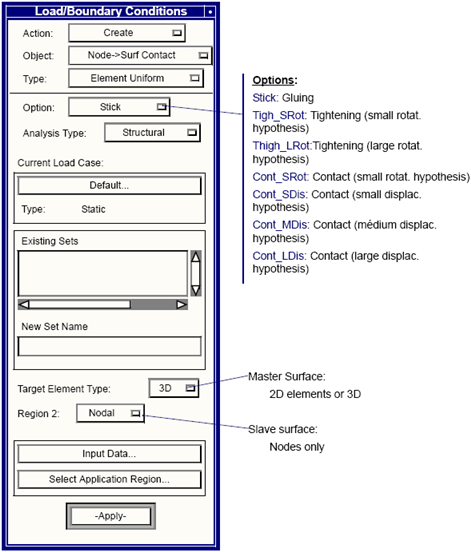
Input Data | Description |
Forces All Defaults | When set to a non zero value, all defaults are taken into account. Defaults are driven by Samcef module. |
Nodes Projection | Forces nodes projection on master surface (topology correction) |
Normal Accuracy | Accuracy used to «drive» the slaved node projection algorithm |
Tangential Accuracy | Accuracy used to «extend» a master face area when the projection of a slave node lies outside the face |
Tightening | Tightening value |
Reference Distance | For each slave node, the pgm computes contact conditions with all the facets which are inside a sphere around the node |
Shells Normals Direction | For shells only. 3 director cosine to indicate normal direction |
Reverse Shells Normals | For shells only. Forces ALL the normals of the shells to be reversed |
Lower Bound | Maximum displacement between the slave nodes and the master surface |
Stop Distance | Offset for the master surface |
Friction Coefficient | Friction value |
Friction Option | Friction law |
Contact Option | Contact option |
Number of Closest Facets | For each node, number of master surface’s faces to be taken into account to detect contact |
Coupled Iteration Method | Select the coupled iteration method |
Uncoupled Iteration Method | Select the uncoupled iteration method |
Reprofiling Only at Time Step | Enable the reprofiling at each time step start instead at each iteration |
Facets Smoothing Transition | Enable the facets smoothing transition algorithm |
Smooting Angle | Smoothing angle for the transition algorithm |
Dummy | If one explicitly defines zeo values for the data above, Patran GUI will not display the LBC,...To by-pass this limitation, setting a non zero for the Dummy data will force Patran to display correctly the Lbc. The Dummy data is not exported to Samcef |
Keyword | Stick | Tigh_ SRot | Tigh_ LRot | Cont_ SRot | Cont_ SDis | Cont_ MDis | Cont_ LDis |
Forces All Defaults | X | X | X | X | X | ||
Nodes Projection | X | X | X | X | X | X | X |
Normal Accuracy | X | X | X | X | X | X | X |
Tangential Accuracy | X | X | X | X | X | X | X |
Tightening | X | X | |||||
Reference Distance | X | X | X | X | X | ||
Shells Normals Direction | X | X | X | X | X | X | |
Reverse Shells Normals | X | X | X | ||||
Lower Bound | X | ||||||
Stop Distance | X | X | X | X | |||
Friction Coefficient | X | X | X | X | |||
Friction Option | X | X | X | ||||
Contact Option | X | X | X | ||||
Number of Closest Facets | X | X | |||||
Coupled Iteration Method | X | X | X | ||||
Uncoupled Iteration Method | X | X | X | ||||
Reprofiling Only at Time Step | X | X | |||||
Facets Smoothing Transition | X | X | X | ||||
Smooting Angle | X | X | X | ||||
Dummy | X | X | X | X | X | X | X |
Keyword | Description |
Forces All Defaults | (Integer) 1=takes all defaults |
Nodes Projection | (Integer) 0=no projection 1=projection |
Normal Accuracy | (Real) strictly positive value |
Tangential Accuracy | (Real) strictly positive value |
Tightening | (Real) |
Reference Distance | (Real) strictly positive value |
Shells Normals Direction | (3 reals) (directors cosine) |
Reverse Shells Normals | (Integer) 0=do not reverse 1=reverse |
Lower Bound | (Real) |
Stop Distance | (Real) strictly positive |
Friction Coefficient | (Real) strictly positive |
Friction Option | (Integer) 0= no friction 1=classical 2=infinite 3=function of velocity |
Contact Option | (Integer) 0= classical contact 1=scratch 2=always |
Number of Closest Facets | (Integer) strictly positive |
Coupled Iteration Method | Any value will enable this option |
Uncoupled Iteration Method | Any value will enable this option |
Reprofiling Only at Time Step | Any value will enable this option |
Facets Smoothing Transition | Any value will enable this option |
Smooting Angle | (Real) strictly positive |
Dummy | (Integer) Non zero |
Keyword | Description |
Forces All Defaults | «All Defaults» not enabled |
Nodes Projection | No projection |
Normal Accuracy | Automatically computed by the algorithm |
Tangential Accuracy | Automatically computed by the algorithm |
Tightening | COMPULSORY |
Reference Distance | Infinite (i.e. all the facets of the master surface can potentially create contact conditions) |
Shells Normals Direction | No direction imposed |
Reverse Shells Normals | No reverse |
Lower Bound | No lower bound active |
Stop Distance | No stop distance |
Friction Coefficient | COMPULSORY if friction is enabled |
Friction Option | 0 (i.e no friction) |
Contact Option | 0 |
Number of Closest Facets | 10 |
Coupled Iteration Method | Coupled Iteration Method is the default |
Uncoupled Iteration Method | |
Reprofiling Only at Time Step | By default, reprofiling occurs at each iteration |
Facets Smoothing Transition | No facet smoothing |
Smooting Angle | 30 degrees |
Keyword | Description |
Forces All Defaults | When set to a non zero value, all other values defined in the other fields of the Input data form are discarded |
Nodes Projection | |
Normal Accuracy | See SAMCEF Contact manual for more details This field has to be filled only in special cases, to help the algorithm in special contact conditions |
Tangential Accuracy | (same as above) |
Tightening | |
Reference Distance | In some cases, can reduce the computation time; in general, this field has to be left empty |
Shells Normals Direction | See SAMCEF Contact manual for more details In the case of shells, the pgm cannot compute from the master surface topology where is the material. By default, normals of elements point to the region of slave nodes (and of course, the material is in the opposite direction); this field forces the pgm to choose normal that is the closest to the given direction |
Reverse Shells Normals | (same as above); this field forces the pgm to change the sign of the element’s default normal. |
Lower Bound | |
Stop Distance | Acts as the master surface has a non-zero thickness (this is, useful for shell thickness modeling) |
Friction Coefficient | Only one value is required as isotropic friction law is assumed |
Friction Option | See SAMCEF Contact manual for more details |
Contact Option | See SAMCEF Contact manual for more details |
Number of Closest Facets | Can be combined with the <Reference Distance> criterion to accelerate the computation; in the major situations, this field has not to be filled |
Coupled Iteration Method | See SAMCEF Contact manual for more details |
Uncoupled Iteration Method | See SAMCEF Contact manual for more details |
Reprofiling Only at Time Step | See SAMCEF Contact manual for more details |
Facets Smoothing Transition | See SAMCEF Contact manual for more details |
Smooting Angle | See SAMCEF Contact manual for more details |
Important: | Contact conditions cannot be used within a model in which cracks have been defined |
Load type | Bacon command | Available for | SAMCEF module |
Stick | .STI | linear, non-linear | ASEF, MECANO |
Tigh_SRot | .CPS | linear, non-linear | ASEF, MECANO |
Tigh_LRot | .MCT | non-linear ONLY | MECANO |
Cont_SRot | .CPS | linear, non-linear | ASEF, MECANO |
Cont_SDis | .MCT | non-linear ONLY | MECANO |
Cont_MDis | .MCT | non-linear ONLY | MECANO |
Cont_LDis | .MCT | non-linear ONLY | MECANO |
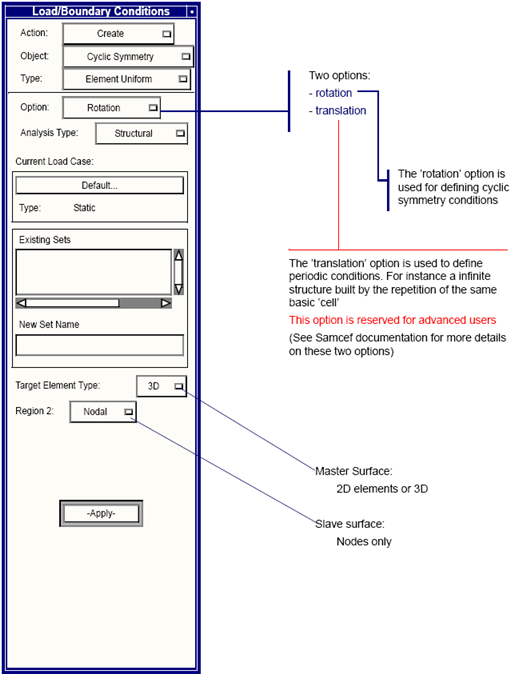
Input Data | Description |
Rotation Axis | To select the X,Y or Z structural axis for the ’rotation’ option. |
Rotation Angle | Define the rotation angle value around the selected axis. The sign of the value defined the direction of the rotation |
Number of sectors | Define the number of sectors for the cyclic symmetry. Therefore the rotation angle will be 360°/number_of_sectors. The sign of the value defined the direction of the rotation |
Wave Number | Select the mode family to be taken into account in the cyclic boundary consitions |
Attribute Number | Attribute attached to the generated MAPP elements. |
Translation Vector | Translation vector of slave nodes (’translation’ option only). |
Nodes projection | Forces nodes projection on master surface (topology correction) |
Normal Accuracy | Accuracy used to «drive» the slaved node projection algorithm |
Tangential Accuracy | Accuracy used to «extend» a master face area when the projection of a slave node lies outside the face |
Dummy | If one explicitly defines zeo values for the data above, Patran GUI will not display the LBC main characteristic, like arrows,... Setting a non zero for the Dummy data will force Patran to display correctly the Lbc. The Dummy data is not exported to Samcef |
Input Data | Rot. Opt. | Trans. Opt. |
Rotation Axis | X | |
Rotation Angle | X(1) | |
Number of sectors | X(*) | |
Wave Number | X | |
Attribute Number | X | X |
Translation Vector | X | |
Nodes projection | X | X |
Normal Accuracy | X | X |
Tangential Accuracy | X | X |
Dummy | X | X |
Input Data | Description |
Rotation Axis | (1 0 0) for global X axis, (0 1 0) for global Y axis, (0 0 1) for global Z axis. Only global axes can de defined. |
Rotation Angle | (Real) |
Number of sectors | (Integer) |
Wave Number | (Integer) strictly positive value |
Attribute Number | (Integer) strictly positive value |
Translation Vector | (Direction Vector). |
Nodes Projection | (Integer) 0=no projection 1=projection |
Normal Accuracy | (Real) strictly positive value |
Tangential Accuracy | (Real) strictly positive value |
Dummy | (Integer) Non zero |
Input Data | Description |
Rotation Axis | COMPULSORY. |
Rotation Angle | COMPULSORY |
Number of sectors | COMPULSORY |
Wave Number | |
Attribute Number | |
Translation Vector | COMPULSORY |
Nodes Projection | projection |
Normal Accuracy | Automatically computed by the algorithm |
Tangential Accuracy | Automatically computed by the algorithm |
Input Data | Description |
Rotation Axis | |
Rotation Angle | ’Rotation Angle’ and ’Number of sectors’ values are mutually exclusive |
Number of sectors | ’Rotation Angle’ and ’Number of sectors’ values are mutually exclusive |
Wave Number | Wave number must be set to zero for static linear analysis Wave number is not required for the ’translation’ option |
Attribute Number | |
Translation Vector | The ’translation’ option defines a periodic condition more than a cyclic symmetry condition |
Nodes Projection | no projection |
Normal Accuracy | Automatically computed by the algorithm |
Tangential Accuracy | Automatically computed by the algorithm |
Load type | Bacon command | Available for | SAMCEF module |
Rotation | .ZYG ROTA | linear, non-linear | ASEF, DYNAM, MECANO |
Translation | .ZYG TRANS | linear, non-linear | ASEF, DYNAM, MECANO |
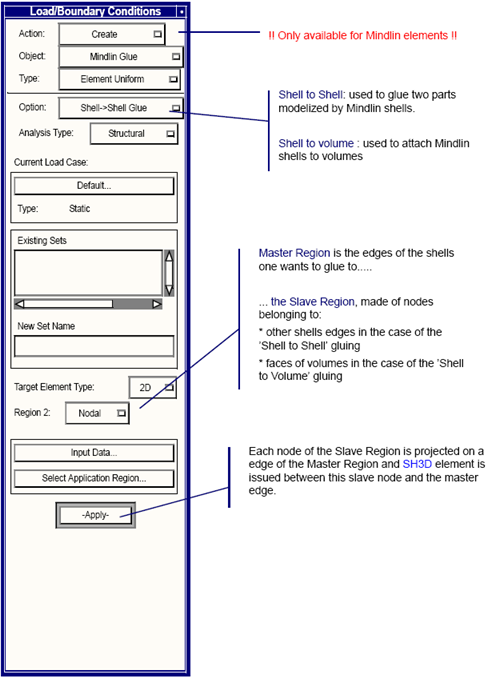
Input Data | Description |
Forces All Defaults | When set to a non zero value, all defaults are taken into account. |
Reference Distance | All shells edges which are at a distance greater than Reference Distance from a slave node are ignored during the projection of the slave node. So between this slave node and a rejected shell edges, no SH3D element is generated |
Input Data | Description |
Forces All Defaults | (Integer) 1=takes all defaults |
Reference Distance | (Real) strictly positive |
Input Data | Description |
Forces All Defaults | «All Defaults» not enabled |
Reference Distance | Infinite (i.e. all the edges of the master surface can potentially be taken into account) |
Input Data | Description |
Forces All Defaults | When set to a non zero value, all other values defined in the other fields of the Input data form are discarded |
Reference Distance | In some cases, can reduce the computation time; in general, this field has to be left empty |
Load type | Bacon command | Available for | SAMCEF module |
Shell to Shell | .APS | linear, non-linear | ASEF, DYNAM, MECANO |
Shell to Volume | .APS | linear, non-linear | ASEF, DYNAM, MECANO |

Input Data | Description |
Sforce (SFx, SFy, SFz) | Surfacic Density of force vector |
Input Data | Description |
Lforce (LFx, LFy, LFz) | Lineic Density of force vector |
Input Data | Description |
PRz | Lineic density of force value on the beam z-axis. |
PRy | Lineic density of force value on the beam y-axis. |
Input Data | Description |
Sforce (SFx, SFy, SFz) | Surfacic Density allows to enter a density of force along arbitrary axes on the contrary of the Pressure lbc which defined a density of force perpendicular to the element. A well know example of the Density of Force is the distributed force the snow on a roof |
Note: | This option is no longer supported. |
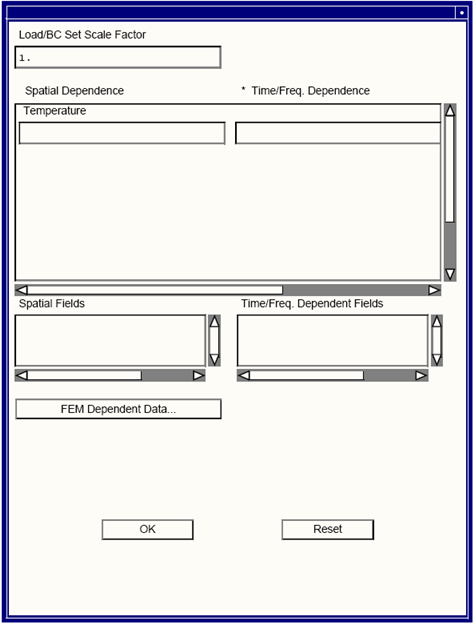
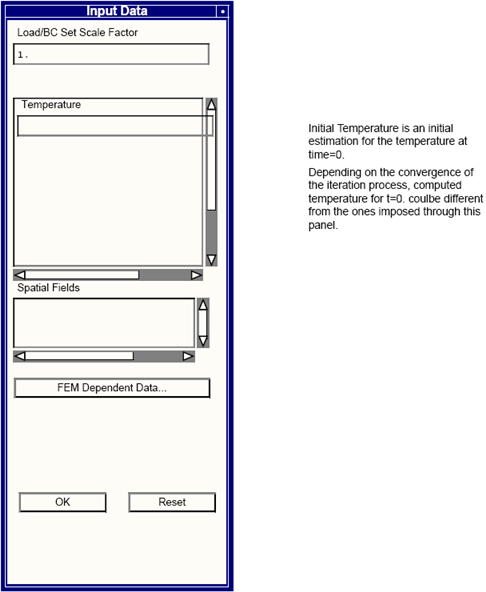
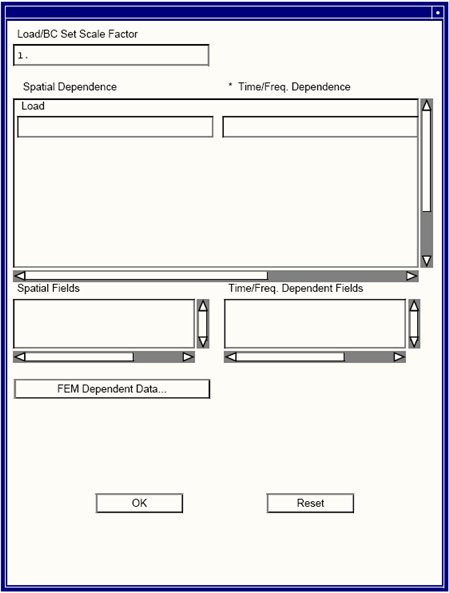
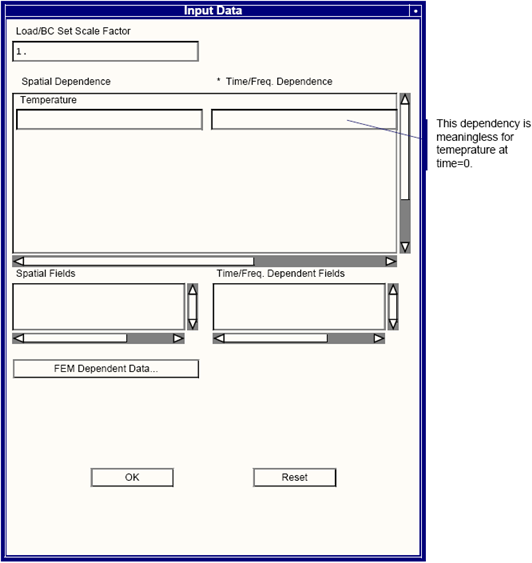
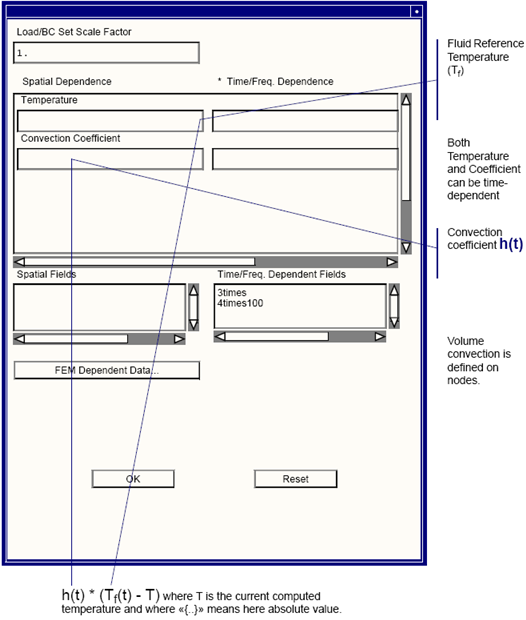
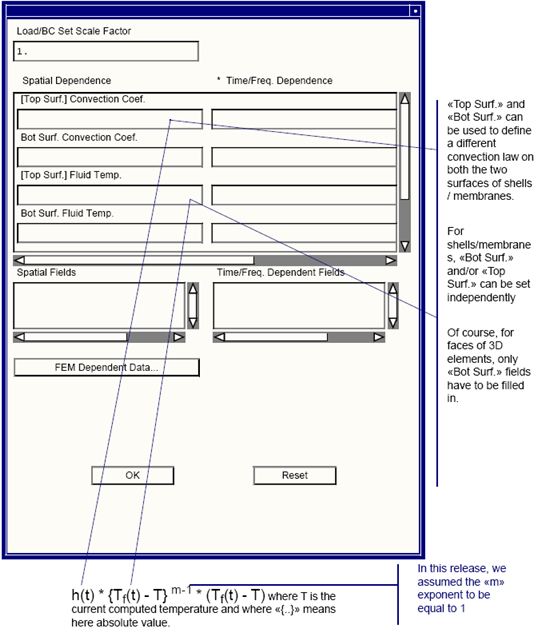
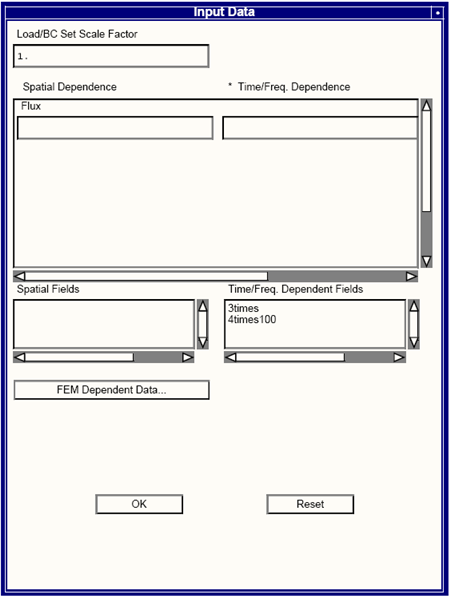
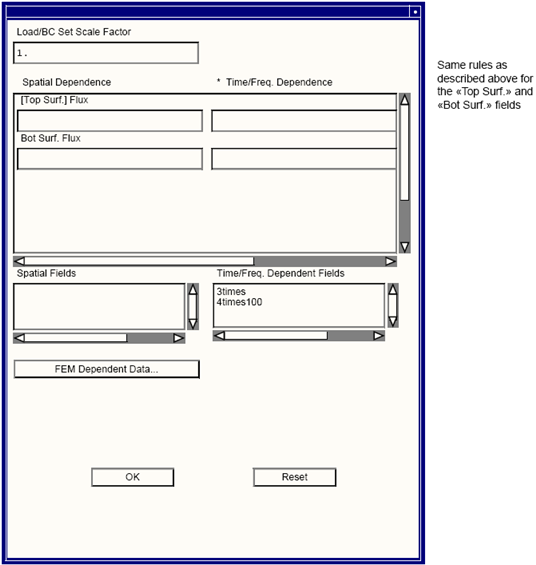
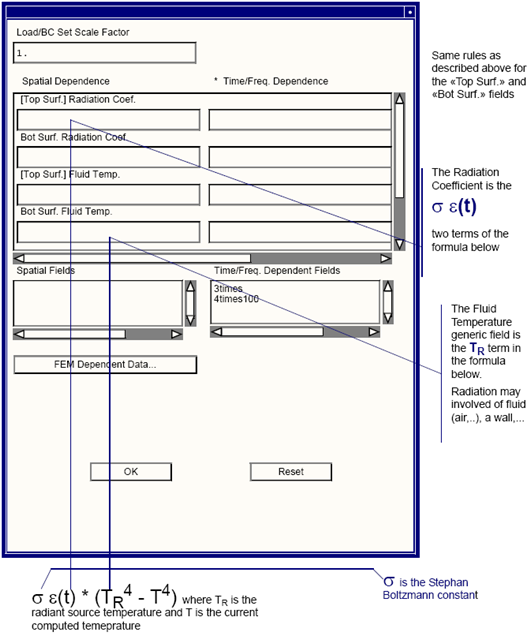
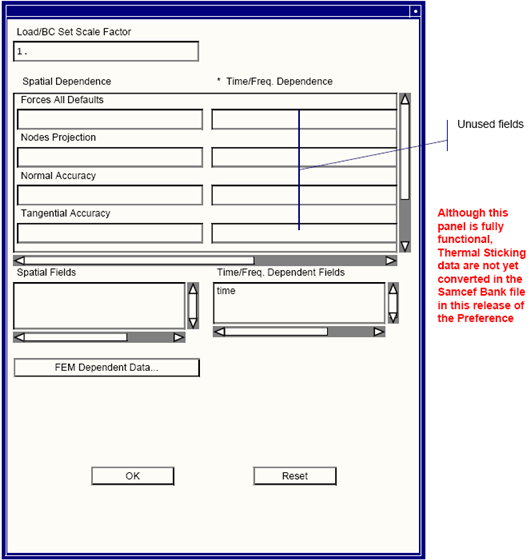
Input Data | Description |
Forces All Defaults | When set to a non zero value, all defaults are taken into account. |
Nodes Projection | Forces nodes projection on master surface (topology correction) |
Normal Accuracy | Accuracy used to «drive» the slaved node projection algorithm |
Tangential Accuracy | Accuracy used to «extend» a master face area when the projection of a slave node lies outside the face |
Keyword | Description |
Forces All Defaults | (Integer) 1=takes all defaults |
Nodes Projection | (Integer) 0=no projection 1=projection |
Normal Accuracy | (Real) strictly positive value |
Tangential Accuracy | (Real) strictly positive value |
Keyword | Description |
Forces All Defaults | «All Defaults» not enabled |
Nodes Projection | No projection |
Normal Accuracy | Automatically computed by the algorithm |
Tangential Accuracy | Automatically computed by the algorithm |
Keyword | Description |
Forces All Defaults | When set to a non zero value, all other values defined in the other fields of the Input data form are discarded |
Nodes Projection | |
Normal Accuracy | See SAMCEF Contact manual for more details This field has to be filled only in special cases, to help the algorithm in special contact conditions |
Tangential Accuracy | (same as above) |
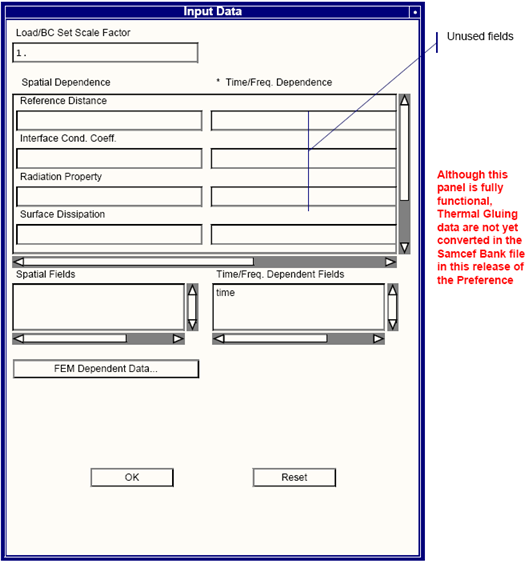
Input Data | Description |
Reference Distance | All shells edges which are at a distance greater than Reference Distance from a slave node are ignored during the projection of the slave node |
Interface Conduction Coefficient | Interface Conductance |
Radiation Property | Emissivity * Stefan-Boltzman constant |
Surface Dissipation | Surface dissipation |
Keyword | Description |
Reference Distance | (Real) strictly positive value |
Interface Conduction Coefficient | (Real) strictly positive value |
Radiation Property | (Real) strictly positive value |
Surface Dissipation | (Real) strictly positive value |
Keyword | Description |
Reference Distance | No reference distance |
Interface Conduction Coefficient | |
Radiation Property | |
Surface Dissipation |
Keyword | Description |
Reference Distance | In some cases, can reduce computation time, but, in general, this field has to be left empty |
Interface Conduction Coefficient | |
Radiation Property | In this release, he same input scalar value is applied to both the master and slave support |
Surface Dissipation | (same as above) |